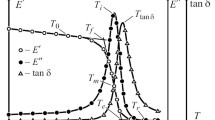Abstract
The measurement of the maximum glass transitionT g∞ of a thermosetting resin is usually performed by differential scanning calorimetry in the second scan (T g2scan), after a previous scan by heating up the sample to a temperature where the exothermic curing reaction has been completed. However, this method can eventually produce thermal degradation, decreasing the crosslinking density and theT g of the sample. Values ofT g2scan between 95† and 102†C were found in an epoxy resin based on DGEBA cured with phthalic anhydride. Thermal degradation effects can be avoided if the measurement is performed by isothermal curing and further determination ofT g. AT g∞ value of 109†C is achieved, which is the maximum value ofT g according to the topological limit of conversion.
Zusammenfassung
Der maximale GlasumwandlungspunktT g∞ on hitzehärtbaren Harzen wird immer mittels DSC im zweiten Scan (T g2scan) gemessen, nachdem in einem ersten Scan die Probe auf jene Temperatur erhitzt wird, bei der die exotherme Härtungsreaktion abgeschlossen wurde. Diese Methode kann jedoch thermischen Abbau verursachen, welcher die Vernetzung sdichte undT g der Probe herabsetzt. Für ein Epoxidharz auf DGEBA-Basis, verhärtet mit Phthalsäureanhydrid wurden fürT g2scan Werte zwischen 95† und 102†C gefunden. Thermische Abbaueffekte können vermieden werden, wenn die Messung mittels isothermer Härtung und anschließender Bestimmung vonT g erfolgt. Es wird einT g∞ Wert von 109†C erreicht, was der höchste Wert fürT g ist und dem topologischen Grenzkonversion entspricht.
Similar content being viewed by others
References
E. F. Oleinik, Epoxy Resins and Composites IV, Ed. K. Dusek, Adv. Polym. Sci., Vol. 80, Springer Verlag, Berlin 1986, p. 49.
M. T. Aronhime and J. K. Gillham, Epoxy Resins and Composites III, Ed. K. Dusek, Adv. Polym. Sci., Vol. 78, Springer Verlag, Berlin 1986, p. 83.
I. Havlicek and K. Dusek, Crosslinked Epoxies, Eds. B. Sedlacek and J. Kahovec, Walter de Gruyter, Berlin 1987, p. 417.
J. B. Enns and J. K. Gillham, J. Appl. Polym. Sci., 28 (1983) 2567.
L. C. Chan, H. N. Naé and J. K. Gillham, J. Appl. Polym. Sci., 29 (1984) 3307.
K. P. Pang and J. K. Gillham, J. Appl. Polym. Sci. 39 (1990) 909.
S. Montserrat, J. Appl. Polym. Sci., 44 (1992 545; J. Thermal Anal., 37 (1991) 1751.
R. B. Prime in Thermal Characterization of Polymeric Materials, Ed. E. A. Turi, Academic Press, New York 1981, Chap. 5, p. 435.
D. J. Plazek and Z. N. Frund, J. Polym. Sci., Part B: Polym. Phys., 28 (1990) 431.
H. E. Bair Am. Chem. Soc., Div. Polym. Chem., Polym. Preprints, 26 (1985) 10.
M. J. Richardson and N. G. Savil, Polymer, 16 (1975 753
G. C. Stevens and M. J. Richardson, Polymer, 24 (1983) 851.
A. Q. Toole, J. Res. Natl. Bur. Stds., 5 (1930) 627.
J. P. Pascault and R. J. J. Williams, J. Polym. Sci., Part B: Polym. Phys., 28 (1990) 85.
A. T. DiBenedetto and L. E. Nielsen, J. Macromol. Sci., Revs. Macromol. Chem., C3, 69 (1969).
Author information
Authors and Affiliations
Rights and permissions
About this article
Cite this article
Montserrat, S. Calorimetric measurement of the maximum glass transition temperature in a thermosetting resin. Journal of Thermal Analysis 40, 553–563 (1993). https://doi.org/10.1007/BF02546625
Published:
Issue Date:
DOI: https://doi.org/10.1007/BF02546625



